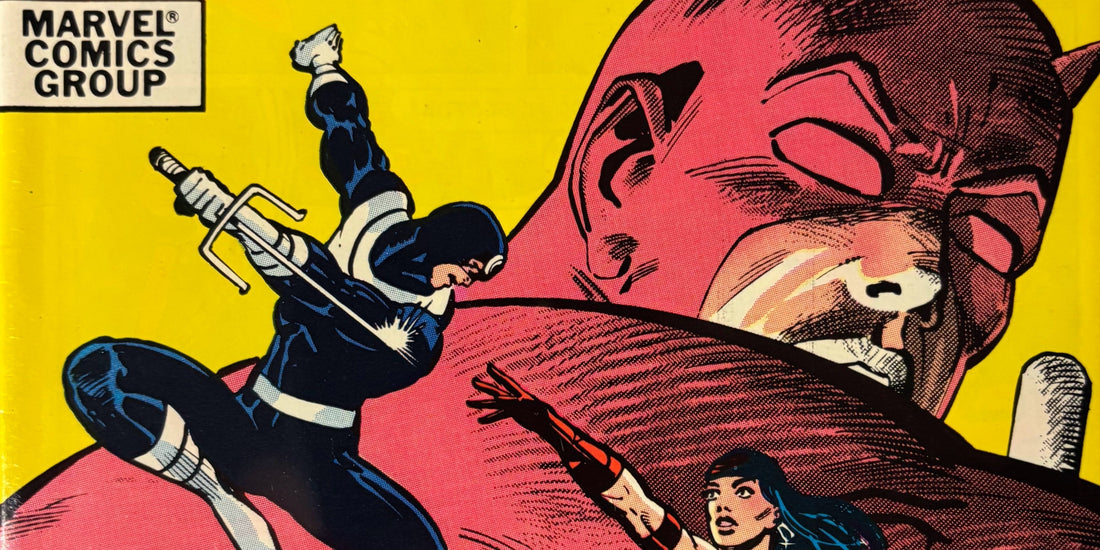Frank Miller's Daredevil: How One Creator Changed the Game
When people talk about Frank Miller, the conversation often jumps straight to The Dark Knight Returns, Ronin, or 300. But before all that, it was his run on Daredevil that established him as one of the most influential creators in comics history.
In the late ’70s, Daredevil was a struggling title on the verge of cancellation. The Man Without Fear was considered a “B-list” hero at best, lacking the sales and prestige of Spider-Man, X-Men, or Avengers. Enter Frank Miller. Drawing on the visual language of film noir, the pacing of crime thrillers, and the kinetic energy of Japanese manga and samurai cinema, Miller transformed Daredevil into one of Marvel’s crown jewels.
The Beginning of a Legend
Miller joined the book in 1979 as a penciler under writer Roger McKenzie, but it was editor Denny O’Neil who recognized Miller’s storytelling instincts and handed him the reins in Daredevil #168 (1981). That single issue not only marked Miller’s debut as writer–artist, it also introduced Elektra, instantly cementing the run as one of the most important in Marvel history.
What followed was a run that redefined Daredevil’s mythology:
-
A Hardboiled Hell’s Kitchen
Miller stripped away the supervillain-of-the-week formula and grounded the series in a street-level crime saga. Hell’s Kitchen became less of a backdrop and more of a character itself—gritty, violent, and unforgiving. Daredevil wasn’t saving the world; he was fighting for survival block by block. -
New Pillars of the Mythos
Beyond Elektra’s tragic arc, Miller added Stick, the no-nonsense martial arts mentor who trained young Matt Murdock, and the Hand, the secretive ninja clan whose shadow loomed large over Daredevil’s world. These creations expanded the scope of the series while keeping it grounded in themes of discipline, loyalty, and corruption.
Villains, Reforged
Miller elevated Wilson Fisk from a Spider-Man villain into Daredevil’s archenemy. Under Miller, Kingpin wasn’t just a mob boss—he was the embodiment of systemic corruption, a mirror to Matt’s struggle for justice. Bullseye, meanwhile, became the ultimate personal foil: sadistic, unpredictable, and defined by his obsession with Daredevil. Their rivalry reached a fever pitch with Elektra’s shocking death in Daredevil #181, a moment that still ranks among Marvel’s most iconic tragedies.
Born Again: The Masterstroke
In 1986, Miller reunited with artist David Mazzucchelli to tell what is often cited as the definitive Daredevil story: Born Again (Daredevil #227–233).
The premise was brutally simple. Karen Page, now addicted to heroin, sells Matt’s secret identity for a fix. The information reaches Kingpin, who doesn’t attack Daredevil physically but dismantles Matt Murdock’s life piece by piece. What follows is a relentless descent: Matt loses his home, his career, his reputation, and nearly his sanity.
But Miller and Mazzucchelli crafted more than just a deconstruction—they built a resurrection. Through faith, perseverance, and sheer will, Matt claws his way back, culminating in a final confrontation with Kingpin that reads like a battle of ideologies as much as fists.
Born Again remains not just a Daredevil classic, but one of Marvel’s greatest stories—layered, brutal, and operatic in its scope.
Lasting Impact
Frank Miller’s tenure on Daredevil did more than rescue a failing book—it redefined the character for every subsequent writer. From Ann Nocenti’s socially charged run to Brian Michael Bendis’s noir-inspired saga and Chip Zdarsky’s modern reinvention, nearly every acclaimed Daredevil story since has been built on foundations Miller laid down.
In many ways, Miller didn’t just save Daredevil—he turned him into Marvel’s most human, most tragic, and most enduring street-level hero.

